1. Introduction

Until now we were used to seeing NVidia's NForce 4 chipset, including the SLI Technology, for the AMD 939 socket. This time around, Asus has adapted the same chipset on a 775 socket for Intel's CPUs with its P5ND2 SLI-Deluxe model. Moreover, the Dual Core technology as well as Intel's EM64T are also supported.
- Features
NVIDIA SLI™ Technology
Ultimate Gaming Performance with NVIDIA SLI™ Technology
NVIDIA® SLI™-Scalable Link Interface- takes advantage of the increased bandwidth of the PCI Express bus architecture and features intelligent hardware and software that allows two GPUs to efficiently work together to deliver earth-shattering, scalable performance. For some applications nearly 2X performance! (From www.NVIDIA.com)"
|

 |
NVIDIA® nForce4 SLI Intel® Edition
NVIDIA nForce4 SLI Intel Edition Notherbridge and MCP-04 Southbridge - The ultimate enthusiast platform
Get the power of NVIDIA® nForce™ 4 SLI for Intel platforms! High performance NVIDIA nForce 4 SLI MCPs deliver comprehensive features for advanced PC security, reliable PC storage, SLI™ technology, PCI Express bus architecture and DualDDR2 memory technology. NVIDIA nForce4 MCPs offer Intel enthusiasts stable, reliable, compatible platform support for ultimate PC performance.
|
 |
- Standard Features
Intel LGA775 Pentium 4 / Celeron CPU
This motherboard supports the latest Intel® Pentium / Celeron CPU in LGA775 package with 1066/ 800/ 533MHz FSB, Hyper-Threading Technology and core-speeds up to 3.8GHz and beyond.
|
 |
Dual-Core CPU
Enjoy the extraordinary CPU power from the latest dual-core CPU.
The advanced processing technology contains two physical CPU cores with individually dedicated L2 Caches to satisfy the rising demand for more powerful processing capability.
(Refer to www.asus.com support site for Intel® Pentium D support list)
|
 |
Intel EM64T
64-bit computing, the next generation technology to replace current 32-bit architecture, delivers advanced system performance, faster memory access and increased productivity. This motherboard provides excellent compatibility and flexibility by supporting either 64-bit or 32-bit architecture. |
PCI Express Architecture
PCI Express is the latest I/O interconnect technology that will replace the existing PCI. With a bus bandwidth 4 times higher than that of AGP 8X interface, PCI Express x16 bus performs much better than AGP 8X in applications such as 3D gaming. PCI Express x1 also outperforms PCI interface with its exceptional high bandwidth up to 500MB/s. The high speed PCI Express interface creates new usages on desktop PCs e.g., Gigabit LAN, 1394b, and high-speed RAID systems. |
- Unique Features
ASUS two-slot thermal design (ASUS exclusive)
ASUS exclusive two-slot thermal design
ASUS two-slot thermal design provides better air-flow and lower VGA cards temperature than other brans' one-slot design, which also ensures better system stability and longer component life cycle.
-
The Asus is unique among the tested SLI boards in providing 3 slots between the x16 PCIe slots used for SLI. All of the other SLI boards provide 2 slots between the video cards. This will be an important feature for users who water-cool their video cards or have special cooling in mind for the pair of SLI cards. ~ (From www.anandtech.com for ASUS A8N-SLI Deluxe review)
-
It offers two x16 PCIe slots, spaced far enough apart to accommodate even graphics cards with monstrous cooling solutions. ~ (From www.tomshardware.com for ASUS A8N-SLI Deluxe review) |
 |
SATA on the Go (External SATA port on back I/O)
SATA on the Go designed for external SATA devices (ASUS exclusive)
The external SATA ports located at the back I/O provide smart setup, hot-plug and support up to 16 devices with port-multiplier functions. Easily backup photos, videos and other entertainment contents on external devices.
ASUS P5ND2-SLI Deluxe supports the next-generation hard drives based on the Serial ATA (SATA) 3Gb/s storage specification, delivering enhanced scalability and doubling the bus bandwidth for high-speed data retrieval and saves. |
 |
AI Quiet
Be Quiet when you value quietness
With PCs serving as the entertainment centerpiece and playing a bigger role in our lives, quiet operation is in high demand. No one wants to hear the cooling fan spinning when watching a movie or listening to music.
The ASUS AI Quiet function (Intel EIST plus ASUS Q-FAN2 technology) dynamically controls CPU speed and reduces temperature and fan speeds when peace and quiet are what you desire. (Note: ASUS AI Quiet function requires Intel 600 series CPU with EIST function)
|
 |
Fanless Design
Provide a cool environment without all the baggage
Cooling fans, though a popular thermal solution, also come with noise and malfunction likelyhood. ASUS Motherboard's fansless concept is specifically created to provide a cool environment without all the baggage.
ASUS has devoted special efforts to address the thermal issues across the motherboard, and most notably the areas that reside the CPU, power, VGA, Northbridge and Southbridge. The heat sinks and strategic board layout were tailor made to dissipate heat in the most efficient manner. |
- Maximizing Gaming Performance
Precision Tweaker
Precision Tweaker is designed for serious overclockers. It offers ways to raise system performance inch-by-inch and step-by-step to achieve maximum performance! This is about getting the most out of your machine, and taking pride in your customized computer. Precision Tweaker provides overclocking options for all major parts of the system: CPU, Memory, PCI-Express, and Front Side Bus. |
AI NOS™
Boost performance when you need it the most!
Applications such as 3D games and video editing demand a huge chunk of system resource.
Inject "nitrous oxide" into your CPU! The patented AI NOS™ (Non-delay Overclocking System) technology intelligently detects system load and automatically boosts performance for the most demanding tasks. Unlike other dynamic overclocking techniques, AI NOS™ reacts much faster to satisfy your unending need for speeds. |
PEG Link for dual VGA cards
Automatically gaming performance tuning for single/dual graphics cards
This latest technology, PEG (PCI Express Graphics) Link Mode, is a unique feature that enables users to boost graphics card performance for superior video quality.
PEG Link allows users to raise GPU and VGA memory throughput via the motherboard BIOS the same way system bus and memory bus are tweaked. PEG Link Mode enables powerful video performance on DX8 and DX9 applications. ASUS engineers carefully fine-tuned the parameters for every single PCI-Express card to provide system stability during high-speed graphics operation. |
ASUS CPU Lock Free
The P5ND2-SLI Deluxe offer the CPU Lock Free feature, which allows you to adjust CPU multiplier to 14x. The reduction of multiplier value provides more flexibility for increasing external FSB frequency to raise memory bus bandwidth. CPU Lock Free boosts overall system performance by making synchronous modification possible. Enjoy better performance at the same CPU operation speed and improve your system without pushing the CPU to the limit. |
C.P.R.(CPU Parameter Recall)
When the system hangs due to overclocking failure, there is no need to open the case to clear CMOS data. Just simply restart the system, the BIOS would show the previous setting and then users can amend the CPU setting again. |
DDR2 800 Support
 To attain top performance, ASUS engineers successfully unleashed the true potential of DDR2 memory. DDR2 800 maximizes system performance by eliminating the bottleneck when overclocking both the CPU and memory, providing great performance for 3D graphics and other memory demanding applications. To attain top performance, ASUS engineers successfully unleashed the true potential of DDR2 memory. DDR2 800 maximizes system performance by eliminating the bottleneck when overclocking both the CPU and memory, providing great performance for 3D graphics and other memory demanding applications. |
- Add-on Features
Dual Gigabit LAN & AI NET2
The integrated dual Gigabit LAN design allows a PC to serve as a network gateway for managing traffic between two separate networks. This capability ensures rapid transfer of data from WAN to LAN without any added arbitration or latency.
ASUS AI NET2 remotely detects cable connection the second you turn on the system, and any faulty connections are reported back up to 100 meters at 1 meter accuracy. |
Dual RAID
The best solution to your RAID requirements on different storage standards.
The NVIDIA MCP-04 Southbridge supports RAID 0, 1, 0+1, 5, and JBOD span cross 4 of Serial ATA 3Gb/s and 4 of Parallel ATA drives, totally up to 8 drives for RAID function.
The Silicon Image Sil3132 controller offers 2 additional SATA 3Gb/s interfaces and allows RAID 0 and RAID 1 functions for best data security. |
ASUS Q-Fan2
ASUS Q-Fan2 technology intelligently adjusts both CPU fan and chassis fan speeds according to system loading to ensure quiet, cool and efficient operation. |
IEEE 1394
IEEE 1394 interface provides high speed digital interface for audio / video appliances such as digital television, digital video camcorders, storage peripherals & other PC portable devices. |
- NVIDIA features
NVIDIA DualDDR2 for high performance memory support
NVIDIA DASP 3.0: The third-generation DASP 3.0 (dynamic adaptive speculative preprocessor) consists of pre-processors that are tasked to track data threads and pre-fetch the appropriate data. It has been re-architected for improved performance and lowest latency.
NVIDIA QuickSync: Designed to allow the use of the highest possible FSB and memory speeds without any negative impact on system performance. It features a patent-pending QuickSync synchronization technology that transfers memory requests and data between the FSB and memory clock domains in the shortest amount of time, thus maximizing system performance. |
NVIDIA ActiveArmor™ - Unmatched security
Dedicated hardware-based ActiveArmor secure networking engine and ActiveArmor Firewall protect your PC from hackers and spyware the minute it is turned on and filters out any unauthorized or suspicious traffic. NVIDIA ActiveArmor secures your PC against a wide range of attacks including IP-spoofing and ARP cache poisoning. Easy to set up and fast to configure, ActiveArmor offers remote secure access, monitoring, and configuration for management. |
NVIDIA MediaShield™ - Advanced storage with RAID technology
Unique support for four SATA 3Gb/s and four ATA-133 drives. RAID 0, RAID 1, RAID 5, and RAID 0+1 support, enabling fast disk data transfers. Allows RAID arrays across both SATA and PATA hard drives and provides advanced features like the NVIDIA disk alert system that immediately alerts you if a drive fails, and dedicated spare disks that will automatically rebuild if a failed hard drive is detected. |
You can see the specifications in the table below:
| CPU |
Socket775 for Intel® Pentium Processor Extreme Edition / Pentium D* / Pentium 4 / Celeron CPU
Compatible with Intel® 05B/05A and 04B/04A processors
Intel® EM64T/ EIST*/Hyper-Threading Technology
* Refer to www.asus.com/support for Intel® Pentium D CPU and EIST support list
|
| Chipset |
NVIDIA® nForce4™ SLI Intel® Edition
NVIDIA® MCP-04 |
| Front Side Bus |
1066 / 800 / 533MHz |
| Memory |
Dual channel memory architecture
4 x 240-pin DIMM sockets support max. 8GB DDR2 800/667/533 non-ECC memory
Support NVIDIA DASP 3.0 (dynamic adaptive speculative preprocessor) and QuickSync features |
| Expansion Slots |
2 x PCI Express x16
- SLI mode: x8, x8
- Default (Single VGA) mode: x16, x1
2 x PCI Express x1
3 x PCI
PCI 2.2
|
| SLI |
Under SLI mode: support two identical SLI-ready graphics cards
Under Default(Single VGA) mode:
- 1 x PCI Express x16 graphics card on the first slot (blue)
- 1 x PCI Express x1 card on second slot (black)
ASUS EZ Selector
ASUS EZ Plug
ASUS SLI Warning LED
ASUS two-slot thermal design
ASUS PEG Link for dual PCI Express graphics cards |
| Storage/RAID |
NVIDIA® MCP-04 Southbridge supports NVRAID
- 2 x Ultra DMA 133/100/66/33
- 4 x Serial ATA 3 Gb/s
- NVRAID: RAID0, 1, 0+1, 5, and JBOD span cross Serial ATA and Parallel ATA drives
- Supports multi-RAID
- Supports up to 8 drives for RAID function
Silicon Image 3132 SATA controller supports
- 1 x Internal Serial ATA 3 Gb/s hard disk
- 1 x External Serial ATA hard disk (SATA On-the-Go)
- RAID 0, 1 |
| LAN |
Dual Gigabit LAN
NVIDIA MCP-04 Southbridge built-in Gigabit MAC with external Marvell PHY supports:
- NV ActiveArmor
- NV Firewall
- AI NET2
Intel 82540EM Gigabit LAN controller |
| Audio |
Realtek ALC850 8-channel CODEC
Universal Audio Jack
Audio Sensing and Enumeration Technology
Coaxial/Optical S/PDIF out ports on back I/O |
| IEEE 1394 |
TI 1394a controller supports:
- 1 x IEEE 1394a port on the rear panel
- 1 x IEEE 1394a connector at midboard |
| USB |
Supports up 10 USB2.0 ports |
| ASUS AI Life Features |
AI Quiet
SATA on the Go (External SATA on back I/O port) |
| Overclocking Features |
Intelligent overclocking tools:
- AI NOS(Non-delay Overclocking System)
- AI Overclocking (intelligent CPU frequency tuner)
- ASUS PEG Link - Automatically performance tuning for single/dual graphics cards
- ASUS CPU Lock Free
- ASUS Ai Booster Utility
Precision Tweaker:
- vDIMM: 8-step DRAM voltage control
- vCore: Adjustable CPU voltage at 0.0125V increment SFS (Stepless Frequency Selection)
- FSB tuning from 133MHz up to 400MHz at 1MHz increment
- Memory tuning from 400MHz up to 1200MHz at 1MHz increment
- PCI Express frequency tuning from 100MHz up to 150MHz at 1MHz increment
Overclocking Protection:
- ASUS C.P.R.(CPU Parameter Recall) |
| Other ASUS Special Features |
Fanless Design
AI NET2 network diagnosis before entering OS
CrashFree BIOS 2
Q-Fan2
MyLogo2
Post Reporter
EZ Flash
Multi-language BIOS |
| BIOS |
Realtek ALC850 8-channel CODEC |
| Back Panel I/O Ports |
1 x Parallel
1 x Optical + 1 x Coaxial S/PDIF Output
1 x PS/2 Keyboard
1 x PS/2 Mouse
2 x RJ45
4 x USB 2.0/1.1
1 x External SATA
1 x IEEE1394
8-Channel Audio I/O |
| Internal I/O Connectors |
1 x SLI selector card connector
3 x USB connectors supports additional 6 USB 2.0 ports
1 x IEEE1394a connector
1 x COM connector
1 x GAME/MIDI connector
CPU Fan / 2x Chassis Fan/ Power Fan connectors
Front panel audio connector
Chassis Intrusion connector
CD / AUX audio in
24-pin ATX Power connector
4-pin ATX 12V Power connector
4-pin EZ Plug power connector |
| Support CD |
Drivers
ASUS PC Probe 2
ASUS Update
ASUS AI Booster
Winbond Voice Editor
NVIDIA NVFirwall
NVIDIA RAID
NVIDIA RIS(Remote Installation Service) application
Anti-virus software (OEM version) |
| Accessories |
InterVideo WinDVD Suite (OEM version)
1 x SLI connector
1 x SLI retention bracket
1 x IEEE1394 port module
5 x SATA cables
SATA power cables for 5 devices
1 x 2-port USB2.0 / Game module
1 x COM Port module
1 x UltraDMA 133/100/66 cable
1 x IDE cable
1 x FDD cable
1 x I/O Shield
User' s manual |
| Form Factor |
ATX Form Factor, 12"x 9.6"(30.5cm x 24.5cm) |
2. The mainboard - Packaging
The P5ND2-SLI Deluxe as with the A8N-SLI Deluxe, is designed on a black PCB. The layout of the interface connections is done in such a way so as to make them easily accessible and the colour coding helps in identifying them.


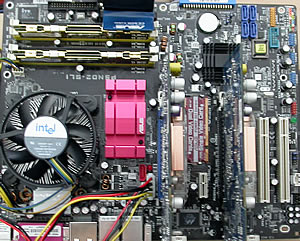
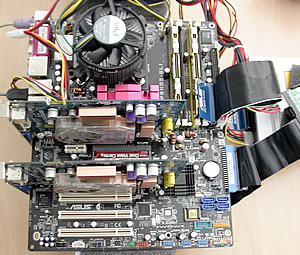
With the P5ND2-SLI Deluxe, Asus has adopted its fanless design, well known from previous latest model motherboards. There are 3 aluminium fanless heatsinks, one for each of the MOSFETs (Metal Oxide Semiconductor Field Effect Transistors), Northbridge and the MCP-04 Southbridge to maintain temperatures at low levels.


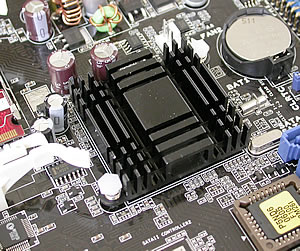
The aluminium heatsink for the NForce4 Northbridge gets quite hot. The temperature on the top surface is close to 65 °C which means that on the chipset itself, it is a lot higher. According to NVidia's specifications, the chipset has a temperature limit of 180 °C.
Below you can see the 775 socket for the Intel CPU.

If you are planning to use a different CPU cooler, other than the stock cooler from Intel, you need to change the position of the jumber located next to the CPU (see photo below). More information about the jumper settings can be found in the included manual.

The memory module slots are colour coded black and yellow. You put two memory modules of the same memory size in the same coloured slots, to enable Dual Channel's symmetry mode support, or use two memory modules of different memory sizes for asymmetric mode.

On the back panel, you will find the keyboard and mouse (PS2) ports, audio port (digital, analog and coaxial), the parallel port, VGA out, 4 USB2.0 ports, two RJ-45 Jacks and one IEEE1394a port. There's also a slot for external Serial ATA. This port, according to Asus, connects to an external SATA box or a Serial ATA multiplier that supports up to 16 devices and enables smart setup and hot-plug functionality.

There are three more connections for extra USB. It seems that SATA RAID will probably be added with the Premium version of this motherboard. The positions are already in place on the motherboard (see photo below).
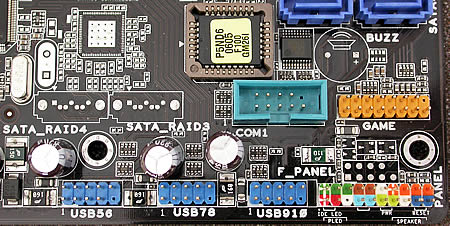
Below you can see the standard IDE channel connectors and the Serial ATA connectors.
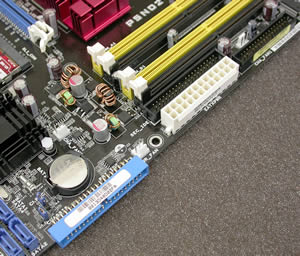
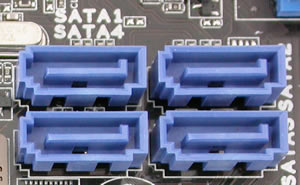
By combining the nForce4 storage capacity with Silicon Image storage capacity, you can connect up to 8 SATA devices. The NVRAID storage (nForce4) supports RAID0, RAID1, RAID 0+1 and JBOD span cross SATA and PATA, while the Silicon Image 3114R RAID controller offers 4 x Serial ATA with RAID0, 1, 0+1, and RAID5.
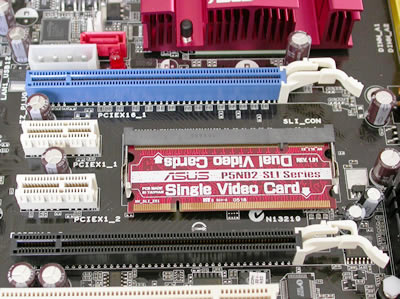
The P5ND2-SLI Deluxe offers two PCI Express slots used for graphics cards and two PCI Express x1 slots. The two PCI Express x16 slots are colour coded. In SLI mode, the user should always remember that the graphics card installed in the blue PCI slot should be considered as the primary VGA card that will handle all signal transfers to the monitors. The secondary card (black slot) is used only for graphics acceleration. The monitor connected to the secondary VGA card will go blank in SLI mode. There are also three PCI slots.
When two VGA cards are used, PCI Express slots share graphics acceleration speed. So, you will have two PCI Express x8 slots. In Single VGA mode, you will have one PCI Express x16 slot (blue) and one PCI Express x1 slot (black).
In order to switch from single VGA mode to SLI mode, the Asus uses a small interface card that will need to be connected accordingly. However, there is an option in the motherboard's BIOS to enable/disable SLI mode, but this interface card should also be setup manually.

A power cable is required for the VGA cards. If this is not connected, the red LED next to the connector will light.
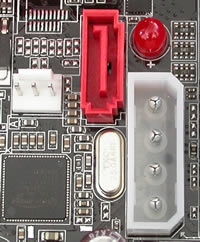
The IT8712F is the newest member of ITE Tech's growing family of Low Pin Count Interface-based Super I/O devices with Environment Controller integration. It provides enhanced hardware monitoring, fan speed control, SmartGuardian control, and it can also support SmartCard reader, Two 16C550 UARTs, one Game port, one parallel and one serial port, floppy disk controller, keyboard controller and one ITE innovative automatic power-failure resume & power button debounce.
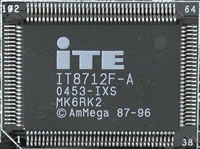
The Marvell Yukon 32-bit 88E1111 offers an additional network connectivity solution. It is Yukon's Gigabit Ethernet controller with Intergrated PHY. It also provides advanced cable diagnostics functions, (Virtual Cable Tester technology) that will enable IT managers to more easily pinpoint the location of cable problems.

The board has a second Gigabit LAN controller, the Intel RC8254.

This small Winbond chip will give your system the ability to speak. It is a programmable speech synthesizer that will inform you if any error occurs in the BIOS self test scanning procedure. Users can edit and change the voices and even add their own voice for every error that might occur.
- The package

The retail package for the P4ND2-SLI Deluxe includes a large list of accessories :
| Accessories |
InterVideo WinDVD Suite (OEM version)
1 x SLI connector
1 x SLI retention bracket
1 x IEEE1394 port module
5 x SATA cables
SATA power cables for 5 devices
1 x 2-port USB2.0 / Game module
1 x COM Port module
1 x UltraDMA 133/100/66 cable
1 x IDE cable
1 x FDD cable
1 x I/O Shield
User' s manual |

For SLI, you'll need the following bridge:
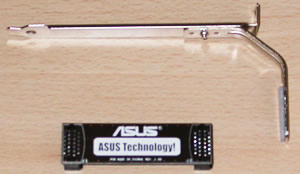
We liked the manual a lot. Very detailed, very helpful...

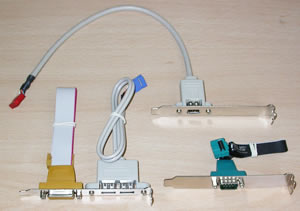
For this review, we populated the ASUS P5ND2-SLI Deluxe motherboard with two ASUS Extreme N6600GT graphic cards and we compared it to the ASUS A8N-SLI Deluxe. The comparison is rather interesting since both boards have been tested in SLI mode with the same VGA cards and the main difference is the CPU, Intel opposed to AMD. So which one is better with SLI? Let's find out.
3. SLI Feature
 With the appearance of the PCI Express x16 bus architecture, NVidia realized that the main idea of using DUAL GPUs to share the load of today's high demand graphical environments could be applied once again, with amazing results. As NVidia says: NVIDIA® SLI™ (Scalable Link Interface) technology is a revolutionary approach to scalability and increased performance. NVIDIA SLI takes advantage of the increased bandwidth of the PCI Express™ bus architecture, and features hardware and software innovations within NVIDIA GPUs (graphics processing units) and NVIDIA MCPs (media and communications processors). Together the NVIDIA SLI patent-pending technologies work seamlessly to deliver heart-pounding PC performance. And depending on the application, NVIDIA SLI can deliver as much as 2x the performance of a single GPU configuration for unparalleled gaming experiences.
With the appearance of the PCI Express x16 bus architecture, NVidia realized that the main idea of using DUAL GPUs to share the load of today's high demand graphical environments could be applied once again, with amazing results. As NVidia says: NVIDIA® SLI™ (Scalable Link Interface) technology is a revolutionary approach to scalability and increased performance. NVIDIA SLI takes advantage of the increased bandwidth of the PCI Express™ bus architecture, and features hardware and software innovations within NVIDIA GPUs (graphics processing units) and NVIDIA MCPs (media and communications processors). Together the NVIDIA SLI patent-pending technologies work seamlessly to deliver heart-pounding PC performance. And depending on the application, NVIDIA SLI can deliver as much as 2x the performance of a single GPU configuration for unparalleled gaming experiences.

First GPU |

Second GPU |
|

Final results of Scalable Link Interface (SLI™)
|
The proportion of GPU load that will be handled by each card is controlled by the nVidia driver. However, a drawback of this technology is that the performance of the system is driver dependent. nVidia provides several gaming profiles with each new driver release to improve the performance of any SLI system.
SLI is enabled through the device driver that is provided with the retail package or from nVidia's web site .

When SLI is enabled for the first time, you will see the following warning message:

At this point, you must use the primary graphics card's monitor signal.

You can also choose to monitor the GPU load for each card. This overlays a green vertical bar on your screen that changes according to the load. The snapshot below is taken under heavy load, during 3DMark05 testing.

From the temperatures seen below in the two snapshots, it can been seen that each card processes a different load.
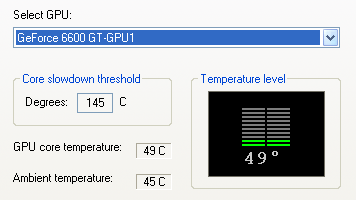
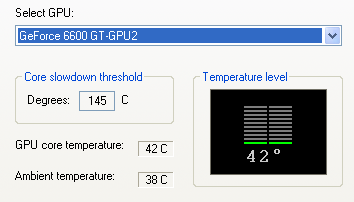
4. Test System
- Processor: Intel P4 3.73Ghz Extreme Edition
- Case: Antec 1080AMG
- Motherboard: ASUS P5ND2-SLI Deluxe
- Memory: 2x512MB OCZ DDR2 PC2-5300 667Mhz
- Hard Disk Drive: WD800JD 80GB 7200RPM
- DVD Burner: LG GSA-4163B
- Power Supply: EzCool 550Watt
- OS: Microsoft WindowsXP Pro SP2
- DirectX: v9.0c
- nVidia Drivers: version 71.84

Benchmarking Software
3DMark05,03,01
PCMark04
Codecreatures Benchmark Pro
AquaMark3 v3.0
Performance Test V5.0
Farcry v1.3
Half Life 2
Doom 3
Thief 3
Ground Control II
Colin McRae '05
5. 3DMark05
 With 3DMark05, Futuremark continues the tradition in its benchmarking software by providing a state-of-the-art Microsoft ® DirectX ® 9 3D performance benchmark.
With 3DMark05, Futuremark continues the tradition in its benchmarking software by providing a state-of-the-art Microsoft ® DirectX ® 9 3D performance benchmark.
3DMark05 is an all new 3DMark version making the most of Microsoft's DirectX
9. The previous version 3DMark03, did a nice introduction into this level
of technology. However
3DMark03 used DirectX 9 specific features in a limited manner, because fully
supporting hardware was rare at the time of its launch. In contrast, 3DMark05
requires DirectX 9 hardware with full support for at least Shader Model 2,
and takes shader usage to never before seen levels.
Just like its predecessors, 3DMark05's point system is set so that at the
moment of release, the high-end VGA cards available in stores can only score
around 5000 3DMarks, whereas the worst card that meets the programs requirements
yields a score of 1000.
Game Test 1 -Return to Proxycon
 Being the sequel to the "Battle of Proxycon"
from 3DMark03, in "Return to Proxycon" we're once again set in space
and the battle continues as space pirates invade a cargo ship in order to
take control of its valuable cargo.
Being the sequel to the "Battle of Proxycon"
from 3DMark03, in "Return to Proxycon" we're once again set in space
and the battle continues as space pirates invade a cargo ship in order to
take control of its valuable cargo.
This test, tries to simulate a future first-person shooter game with all the high details that entails. The dynamic shadows, high-detailed environment and advanced lighting techniques ensure that under normal circumstances, no recent card can run it with decent frame rates.
Game Test 2 - Firefly Forest
 A forest gets filled with magic fireflies in the night. The moon is nearly full, illuminating the forest with a bluish faint light. The magic fireflies have flickering bright green lights that playfully move around the forest.
A forest gets filled with magic fireflies in the night. The moon is nearly full, illuminating the forest with a bluish faint light. The magic fireflies have flickering bright green lights that playfully move around the forest.
This scene is a nice example of a smaller scale outdoor scene with rich vegetation. Immediate visibility is not so far, and there is a skybox surrounding the whole scene.
A large number of trees with their branches swinging separately, and dense vegetation being dynamically distributed according to the camera movements, make this test the most demanding of the three.
Game Test 3 - Canyon Flight
 A Jules Verne type airship flies through a canyon guarded
by a dangerous sea monster. The airmen defend their ship using heavy cannons,
but these seem to have no effect on the huge sea monster. Finally the crew
manages a narrow escape using the "last resort" afterburners of
the airship.
A Jules Verne type airship flies through a canyon guarded
by a dangerous sea monster. The airmen defend their ship using heavy cannons,
but these seem to have no effect on the huge sea monster. Finally the crew
manages a narrow escape using the "last resort" afterburners of
the airship.
This scene is fairly complex with large areas of water
reflecting the high canyon walls. The water actually is one of the key points
of interest in this scene. The water not only does realistic looking reflections
and refractions, it has a depth fog, making the sea monster swimming under
the airship actually look deep down in the water. The air in this scene also
uses a volumetric fog, making distant cliffs of the canyon really look far
away.

The difference in frame rates is not too great and probably might be mostly due to the different CPUs rather than the motherboards.
Final Score
3DMarks on 3DMark05 are now calculated by the following formula:
(Game Test 1 * Game Test 2 * Game Test 3)^0.33 * 250
This is basically the geometric mean of the total frames in each
game multiplied by 250. This means that all game tests are now equal.

Better performance from the Intel based motherboard.
6. 3DMark03
 3D Mark is a widely used and accepted benchmark that stresses the DirectX performance of a VGA card. A very strong point of 3DMark is that it's VGA card measuring is does not require any CPU power. So the resulting fps are a good reference a VGA card's rendering performance. For testing the performance of each card we used the 4 game benchmarks 3DMark has.
3D Mark is a widely used and accepted benchmark that stresses the DirectX performance of a VGA card. A very strong point of 3DMark is that it's VGA card measuring is does not require any CPU power. So the resulting fps are a good reference a VGA card's rendering performance. For testing the performance of each card we used the 4 game benchmarks 3DMark has.
3Dmark03 also includes sound and CPU tests as well as some other feature tests.
- Game Test 1 - Wings of Fury (DX7)

This test is a combat flight simulator written for older hardware (DirectX 7). Particles are used a lot in this test - smoke and vapor trails, flak and gunfire, and explosions are produced using point sprites and quads.
- Game Test 2 - Battle of Proxycon (DX8)

This test is a simulation of first person shooter game types. 1.1 and 1.4 Vertex shaders are widely used since all character models are skinned using vertex shaders.This makes this test a good vertex shader comparison for VGA cards.
- Game Test 3 - Trolls' Lair (DX8)

This test should be the favorite of all RPG lovers. It is a cut scene of a female warrior facing two malicious trolls. Again the same vertex and pixel processing is used as in game test 2.
This test also uses post-processing effects, such as Depth of Field and Bloom effects which are widely used in today's game cut scene sequences.
- Game Test 4 - Mother Nature (DX9)

Mother nature represents the level of effects and realism that are possible using 2.0 vertex and pixel shaders, plus some other features that DirectX 9 offers.
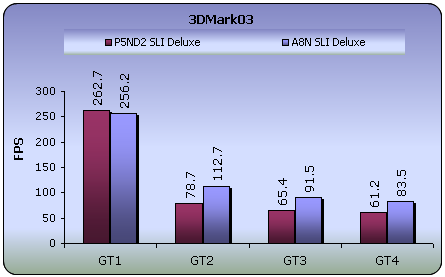
Other than the GT1 benchmark, the A8N motherboard reported much higher frame rates.
- 3DMark Official score
If you test your machine with 3DMark, you can post the results at 3DMark's online result browser. For more information visit futuremark.com.
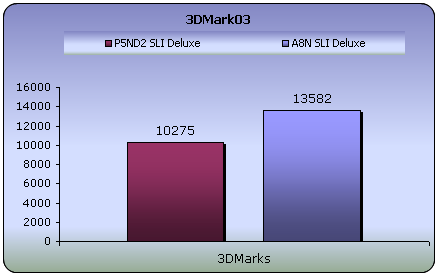
7. Codecreatures
 CodeCreatures is a synthetic 3D benchmark that is a good reference for VGA performance comparison. This is a high-end 3D benchmark that also requires DirectX 8 hardware, making a good tool for measuring the potential of DirectX 8 game performance.
CodeCreatures is a synthetic 3D benchmark that is a good reference for VGA performance comparison. This is a high-end 3D benchmark that also requires DirectX 8 hardware, making a good tool for measuring the potential of DirectX 8 game performance.
The Codecreatures benchmark is written with Microsoft's DirectX 8.1 API and incorporates the use of Vertex and PixelShaders popular on next generation 3D accelerators.

The benchmark plays a photo-realistic nature scene and calculates the performance of the graphics adapter by measuring the fps that it can display at 1024x768, 1280x1024 and 1600x1200 resolutions.
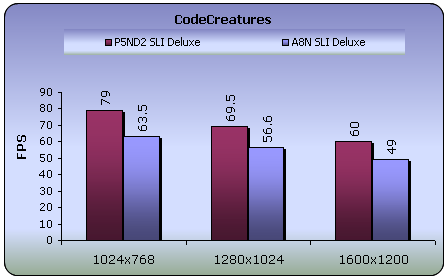
-Codecreatures number
The codecreatures number is the resulting score of the total
benchmarking process and is basically the geometric mean of the three frame
rates multiplied by 100.
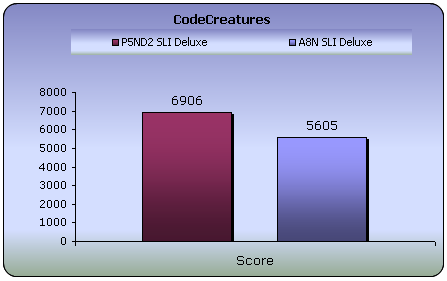
The numbers speak for themselves...
8. Aquamark/3DMark 2001
 Since the majority of today's applications and games are compatible with DirectX 9, the need of benchmark applications that use DX 9 has been brought up. The benchmark uses the 3D engine (Krass engine) of the Aquanox game.
Since the majority of today's applications and games are compatible with DirectX 9, the need of benchmark applications that use DX 9 has been brought up. The benchmark uses the 3D engine (Krass engine) of the Aquanox game.
Aquamark Triscore
The Aquamark Triscore comprises 3 values: the overall system performance, the performance of the graphics system and the CPU performance. Keep in mind that this is not the total result of the tests, but the result of the whole benchmark process including all 9 chapters.

3DMark 2001
3DMark 2001 is the predecessor to 3DMark03. It's mainly a directx8.1 benchmark and the score depends a lot on the CPU power of your computer. However for reference use only we decided it'd be best to just leave it in our benchmark list so you can compare the next generation cards with the possibly outdated you have at home.

Better performance in both 3DMark01 and Aquamark 3 for the P5ND2-SLI Deluxe motherboard with the Intel CPU. This performance is close to that of the X850XT graphics card.
9. Half Life 2
Half life 2 is no doubt the most anticipated pc game of all times. Gamers keeping the excellence of Half Life 1 in their mind as well as the remarkable E3 demo preview, have been anxiously waiting for the much delayed release of HL2.
 Characters - Advanced facial animation system delivers the most sophisticated in-game characters ever seen. With 40 distinct facial "muscles," human characters convey the full array of human emotion, and respond to the player with fluidity and intelligence.
Characters - Advanced facial animation system delivers the most sophisticated in-game characters ever seen. With 40 distinct facial "muscles," human characters convey the full array of human emotion, and respond to the player with fluidity and intelligence.
Physics - From pebbles to water to 2-ton trucks respond as expected, as they obey the laws of mass, friction, gravity, and buoyancy.
 Graphics
- Source's shader-based renderer, like the one used at Pixar to create movies
such as Toy Story® and Monster's, Inc.®, creates the most beautiful
and realistic environments ever seen in a video game.
Graphics
- Source's shader-based renderer, like the one used at Pixar to create movies
such as Toy Story® and Monster's, Inc.®, creates the most beautiful
and realistic environments ever seen in a video game.
AI - Neither friends nor enemies charge blindly into the fray. They can assess threats, navigate tricky terrain, and fashion weapons from whatever is at hand.
To measure performance we used the Video Stress Test(VST) that is available in the CounterStrike:Source beta available through Steam. We set all the details to the highest level and each time changed the resolution from 800x600 up to 1600x1200.

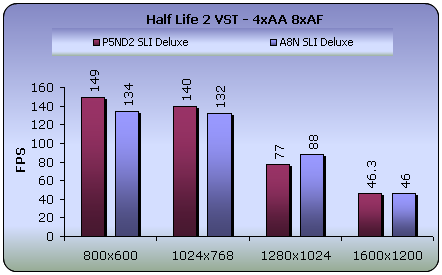
Without any Anti-Aliasing or Anisotropic filtering enabled, the performance of both boards is similar. However, when we set Anti-Aliasing to 4X and Anisotropic Filtering to 8X, the P5ND2-SLI Deluxe with the Intel CPU reported higher frame rates.
10. Doom 3

A massive demonic invasion has overwhelmed the Union Aerospace Corporations? (UAC) Mars Research Facility leaving only chaos and horror in its wake. As one of the few survivors, you struggle with shock and fear as you fight your way to Hell and back, in an epic clash against pure evil.
Activision made it's miracle again with Doom 3 which is said to be the best-looking game ever, thanks to the brand-new OpenGL graphics engine used to generate its convincingly lifelike, densely atmospheric, and surprisingly expansive environments. If you are a fan of the previous Doom games then you will get many flashbacks with this revision, since you will find re-imagined versions of almost every monster from both Doom and Doom II.

To measure performance on the game we used the timedemo demo1 command from the console (Alt+Ctrl+~).
Enabling the high quality setting and executing the timedemo demo1 command twice for each resolution, we witnessed the following:
First, without the Anti-Aliasing and Anisotropic Filtering settings
enabled, we got the following results:
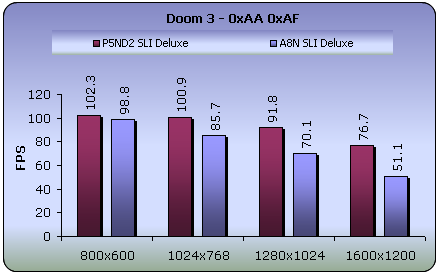
The higher the resolution, the larger the difference between the two boards.
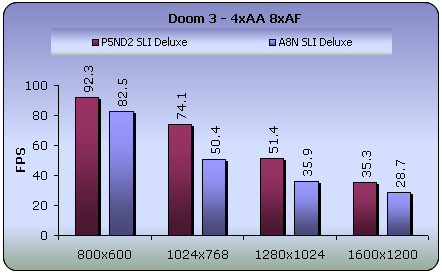
The same scene with Anisotropic filtering and Anti-Aliasing enabled.
11. FarCry

 You are Jack Carver running your own boat charter business in beautiful Micronesia. With a past best left behind you, you'll be focusing on your present assignment: escorting an ambitious journalist named Valerie Cortez to the Island of Cabatu. It seems like a piece of cake, but you'll soon learn: paradise can be hell.
You are Jack Carver running your own boat charter business in beautiful Micronesia. With a past best left behind you, you'll be focusing on your present assignment: escorting an ambitious journalist named Valerie Cortez to the Island of Cabatu. It seems like a piece of cake, but you'll soon learn: paradise can be hell.
Farcry is an awesome First Person Shooter (FPS) based on a last generation 3D engine named as CryEngine. Real-time editing, bump-mapping, static lights, network system, integrated physics system, shaders, shadows and a dynamic music system are just some of the state of-the-art features that the CryEngine offers.
A great advantage and strong point of the CryEngine is its physics system which supports character inverse kinematics, vehicles, rigid bodies, liquid, rag doll, cloth and body effects. All physics seem to be very realistic and you never get bored when facing enemies, since character models have multiple animations that blend in believable ways.
With an integrated shader system and a massive terrain which maximizes
the view distance to 2km, these features make Farcry a perfect action game and
also a referable benchmark to speak of.
- Benchmark Settings
For this game we recorded a custom demo from the start of the Rebellion
stage. We chose an indoor scene in order to avoid getting the CPU-bound effect. This will result in slightly higher results since it is also less
GPU intensive, but we can't afford being stuck at 40-50 fps because of our CPU.

The latest patch (1.3) was used for our tests which updates the
game's graphics engine to use the 3.0 Shader model. This option is only supported
for the 6800 series.

The resolutions we ran the demo under are the following: 800x600,1024x768,
1280x1024 and 1600x1200.
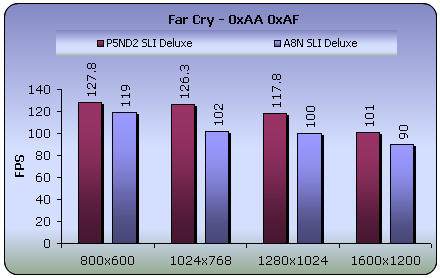

Same story here, the P5ND2 SLI Deluxe reported better performance.
12. Thief 3
 Instead
of Deus Ex from now on we'll be testing our cards using Thief 3. It's based
on the same engine but it's much less GPU intensive and playable by more VGA
cards than
Instead
of Deus Ex from now on we'll be testing our cards using Thief 3. It's based
on the same engine but it's much less GPU intensive and playable by more VGA
cards than  Deus.
Deus.
The game makes severe use of Pixel Shader 1.1 instructions, the bloom effect and stencil shadows to achieve a wonderful result in your screen.
In the game you play the part of Master Thief Garrett who is back to rule out any evil forces using his unique stealth abilities. Deadly Shadows shows what stealth gameplay is all about. This game really gives you the feel of sneaking around and holding your breath when stuck in a sticky situation.
Since there is no official benchmark for the game, we'll do our tests using
a GPU intensive scene from the tutorial-level which we believe that represents
the average fps you'll get when playing the game.
Thief 3 is a torture test for graphics cards. All lower class cards fail to provide stable performance in this benchmark when selecting full details from the settings menu.
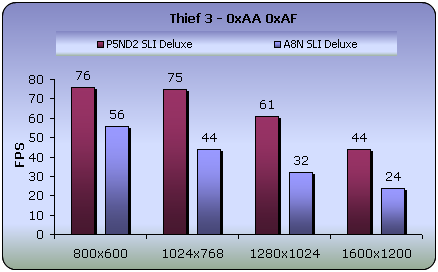
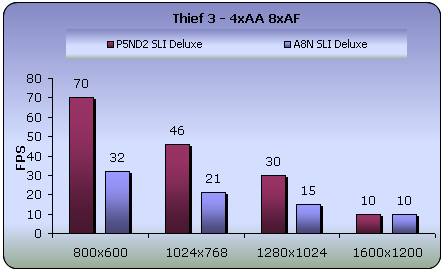
There is a great difference between the reported frame rates. In all cases the P5ND2 SLI Deluxe motherboard was better, regardless of whether Anisotropic filtering and Anti-Aliasing were enabled or not, with the exception at 1600X1200 where the reported frame rates were the same for both boards.
13. Colin McRae 2005
 For all you racing fans out there, this test is for you and will represent the Racing game category in our benchmarks.
For all you racing fans out there, this test is for you and will represent the Racing game category in our benchmarks.
From the graphics point of view the first thing you'll
notice in the game is the excellent amount detail of your racing car. High
resolution textures on the car and lighting make it quite impressive. All
the eye candy such as the sun reflection in the virtual camera are still the
same as the older CM versions but motion blur has been added when your card
hits something hard which will happen most often if you're new to the racing
simulation world.
To measure performance on the game we used fraps to get the average fps of the whole 8th stage of UK which is actually the only stage you get to play on the demo.
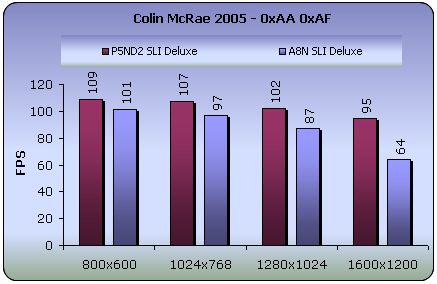
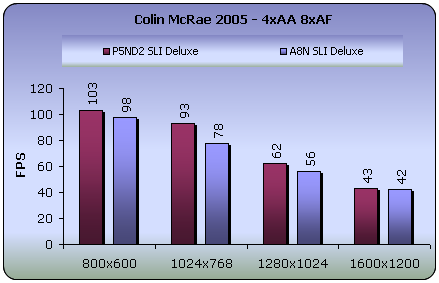
Higher frame rates for the P5ND2 SLI Deluxe board with the Intel CPU. As was the case with Thief 3, at 1600X1200 with Anisotropic filtering and Anti-Aliasing enabled, the two boards reported similar performance, probably because the VGA cards have reached their limits.

14. Ground Control
 Ground
Control 2 is an action-oriented game of tactics and warfare. As Captain Jacob
Angelus of the Northern Star Alliance, you will command squads of infantry,
artillery, and air power against the might of the Empire of Terra. Base building
and resource-collecting are replaced with unit control and combat tactics where
your knowledge of the battlefield maneuvers will make the difference in your
fight against a ruthless enemy. Position your troops on hilltops for better
aim or inside buildings and forests for protection as you'll need to use every
inch of terrain to your advantage.
Ground
Control 2 is an action-oriented game of tactics and warfare. As Captain Jacob
Angelus of the Northern Star Alliance, you will command squads of infantry,
artillery, and air power against the might of the Empire of Terra. Base building
and resource-collecting are replaced with unit control and combat tactics where
your knowledge of the battlefield maneuvers will make the difference in your
fight against a ruthless enemy. Position your troops on hilltops for better
aim or inside buildings and forests for protection as you'll need to use every
inch of terrain to your advantage.
For our benchmarks, we used the highest possible settings on the first mission
of the single player game and moved around the camera to get an average frame
rate using fraps.

Ground Control II offers really impressive graphics without requiring much GPU power. Click on the picture above to view a screenshot from the game. Check out these excellent water effects!


Since the benchmark is not very GPU intensive, the difference between the two boards is dependent on the CPU and the motherboard itself. No matter what the resolution, the P5ND2 SLI Deluxe reported far higher frame rates.
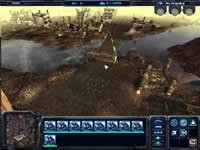
15. PassMark
The suite of the PassMark Performance Test contains a number of suites with different teststo measure different aspects of a computer system.
The "PassMark rating" is a weighted average of all the other test results and gives a single overall indication of the computers performance. The bigger the number, the faster the computer. The "PassMark rating" can only be calculated if the results from all other tests are available. The value is calculated as follows.
| Test Suite |
Weighting |
| Disk |
20% |
| CD / DVD |
9% |
| Memory |
18% |
| 3D Graphics |
12% |
| 2D Graphics |
14% |
| CPU |
27% |
| Total |
100% |
The total score for the P5ND2 SLI Deluxe is:

More details:
16. Overclocking
You can increase your Asus P5ND2-SLI Deluxe board's system performance with the AiBooster utility, bundled in the software package. The default FSB for the Pentium 4 3.73Ghz Extreme Edition is 1066Mhz.

The maximum overclocking we managed to achieve was up to 4.28Ghz with FSB running at 1220Mhz. We tried both with AiBooster and through the BIOS. At higher speeds, we had blue screens or the system failed to boot.

17. Bios - Page 1

Asus Logo

Main Boot Screen

Bios main Screen
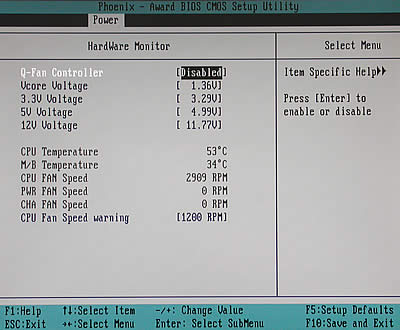
Hardware Monitor


18. Bios - Page 2
The BIOS features for advanced use, such as overclocking:

First, you'll have to set the Overclocking profile to manual, in order to be able to adjust the settings yourself. There are also some pre-set profiles for overclocking.

You can also adjust the FSB speed or Memory speed, both together or separately.
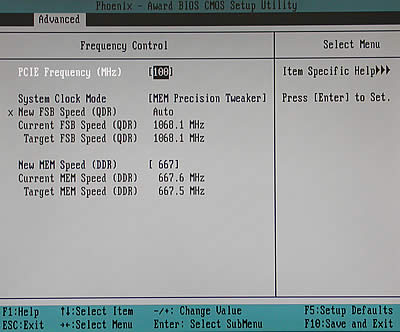
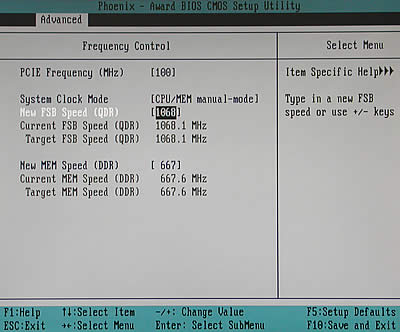
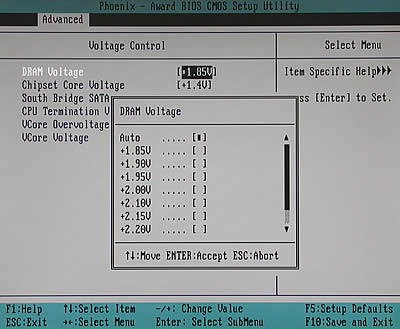
Memory Voltage
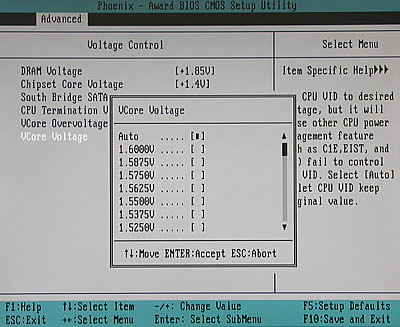
CPU Voltage
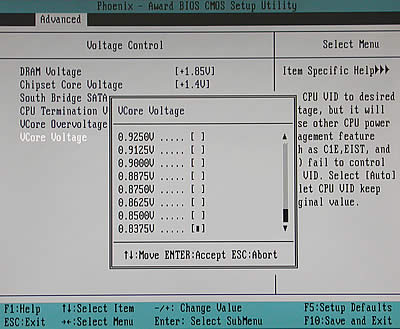
CPU Voltage


The timings for the memory can also be set manually:

19. Software - Asus Update
The Software CD included in the retail package includes the following:
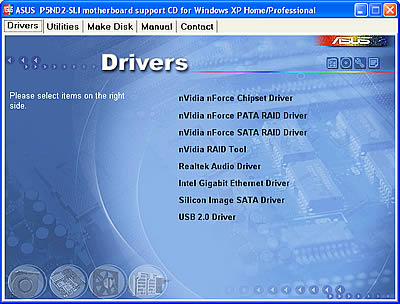
Drivers
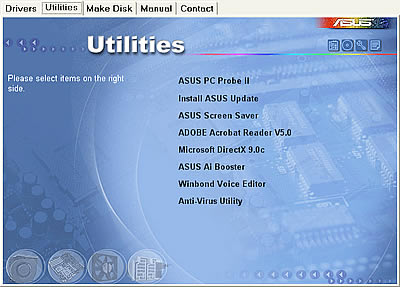
Utilities
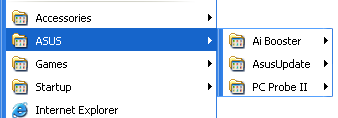
Asus Update is a very helpful utility which helps locate the appropriate firmware revision for the motherboard and then flash it.

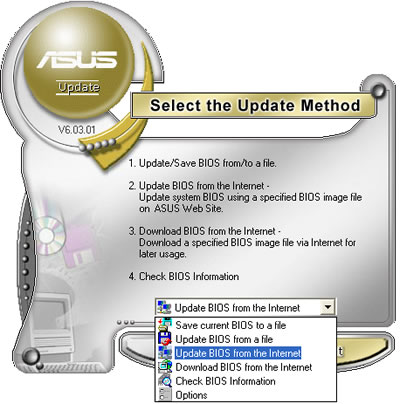
We highly recommend that you first download the new BIOS from the internet and then proceed with the flash procedure.
You can see the BIOS details with the appropriate selection from the drop down menu.
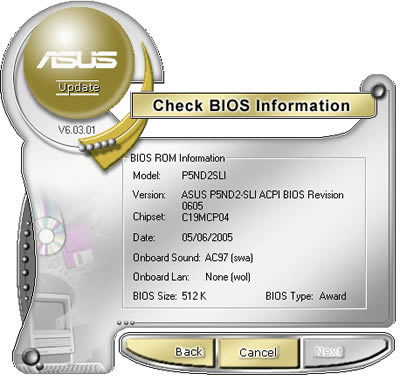
20. Asus PCProbe2
We highly recommend you install this software. It will provide you with helpful information about your system.
This time Asus has upgraded its PC Probe, providing a more impressive layout.

Voltage, temperatures, fan speed are some of the parameters you can monitor.
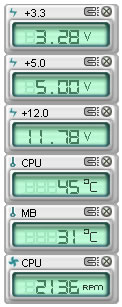
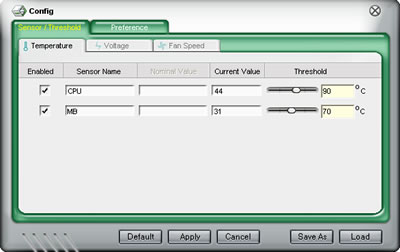
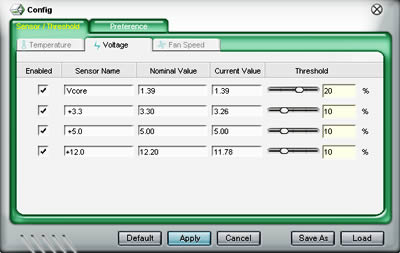
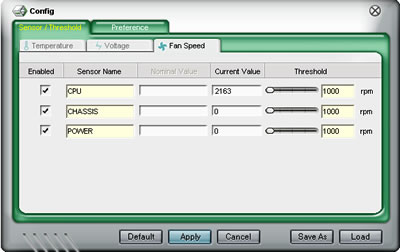
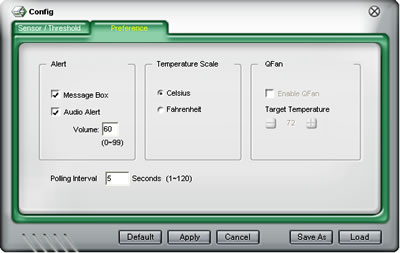
You can also be informed about the HD and RAM conditions as well as CPU Usage.
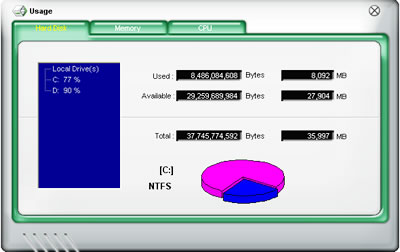
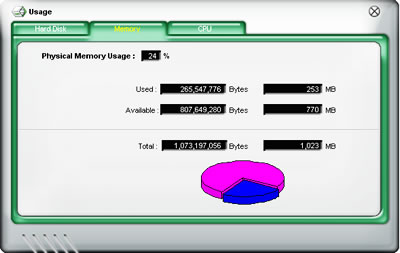
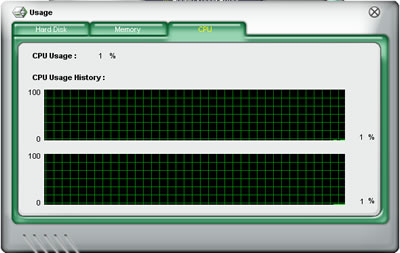
21. AIBooster
AIBooster is a convenient utility in order to overclock your system. There is no need to use the BIOS with this utility although we still think the BIOS is still the safest way to go.


You can select between some pre-defined overclocking profiles, the same as those you'll find in the BIOS.

 .
.

You also have the ability to manually adjust the CPU or Memory Voltage as well as the FSB speed.

After any changes, you'll have to restart your system. You'll be informed by the appropriate message.

22. Conclusion
Beginning with the retail package, we can say that there isn't anything you can think of that is missing. All cables are included while the very helpful manual will help you during everything step. The black colored PCB looks rather impressive as well, with the colour coded interface connections. PCI-Express with SLI support, double Gigabit LAN, HD-AUDIO, SATA RAID, Dual Channel, N.O.S. are only some of the board's long list of features. Maybe a WireLess LAN or IDE in RAID mode are something we would like to see.
The board uses fanless cooling which is something you'll notice from the start. This means virtually no noise at all. The only thing we noticed was that the 65°C from the heatsink on the NForce4 chipset, increases the temperature of the board itself. However, there is no danger at all for the chipset since its limit is close to 180 °C.
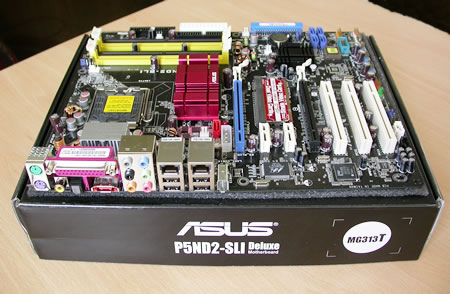
In comparison to the A8N-SLI Deluxe, the P5ND2-SLI Deluxe had better overall performance as a result of the P4 3.73Ghz Extreme Edition we used.
The price at the time of this review was US$220 at newegg.com. This is a good price if we keep in mind what the board offers, its performance and the overall package. On the other hand, in comparison to the A8N-SLI Deluxe, it is kind of expensive.

Pros:
- Excellent features
- Good Retail Package
- Very Good performance
- Monitor utility from within Windows
- SLI support
- Q-Fan and AI NOS features
- Great motherboard overclocking capabilities
Cons:
Like to be fixed
- How about two extra IDE channels in Raid Mode?
- A lower price would be welcome
| Features |
|
| Performance |
 |
| BIOS/Overclocking |
|
Value for money |
|